Can We Use the QA4ECV Black-sky Fraction of Absorbed Photosynthetically Active Radiation (FAPAR) using AVHRR Surface Reflectance to Assess Terrestrial Global Change?
Abstract
1. Introduction
2. Data Used
3. Methods
4. Benchmark Results
4.1. Validation Using Ground-Based Measurements
4.2. Quality Control of Monthly Time Series over 1982–2006
4.3. Daily Products at 0.05° × 0.05°
4.4. Monthly Products at 0.5° × 0.5°
4.5. Global Change Studies: Impact of Calibration
5. Conclusions
Author Contributions
Acknowledgments
Conflicts of Interest
References
- Sellers, P.J.; Dickinson, R.E.; Randall, D.A.; Betts, A.K.; Hall, F.G.; Berry, J.A.; Collatz, G.J.; Denning, A.S.; Mooney, H.A.; Nobre, C.A.; et al. Modeling the Exchanges of Energy, Water, and Carbon Between Continents and the Atmosphere. Science 1997, 275, 502–509. [Google Scholar] [CrossRef]
- Knyazikhin, Y.; Martonchik, J.V.; Myneni, R.B.; Diner, D.J.; Running, S.W. Synergistic algoritm for estimating vegetation canopy leaf area index and fraction of absorbed photosynthetically active radiation from MODIS and MISR data. Geophys. Res. 1998, 103, 32257–32276. [Google Scholar] [CrossRef]
- Disney, M.; Muller, J.P.; Kharbouche, S.; Kaminski, T.; Vossbeck, M.; Lewis, P.; Pinty, B. A New Global fAPAR and LAI Dataset Derived from Optimal Albedo Estimates: Comparison with MODIS Products. Remote Sens. 2016, 8, 275. [Google Scholar] [CrossRef]
- Chernetskiy, M.; Gómez-Dans, J.; Gobron, N.; Morgan, O.; Lewis, P.; Truckenbrodt, S.; Schmullius, C. Estimation of FAPAR over Croplands Using MISR Data and the Earth Observation Land Data Assimilation System (EO-LDAS). Remote Sens. 2017, 9, 656. [Google Scholar] [CrossRef]
- Knorr, W.; Kaminski, T.; Scholze, M.; Gobron, N.; Pinty, B.; Giering, R.; Mathieu, P.P. Carbon Cycle Data Assimilation with a Generic Phenology Model. J. Geophys. Res. Biogeosci. 2010, 115, G04017. [Google Scholar] [CrossRef]
- Kaminski, T.; Knorr, W.; Scholze, M.; Gobron, N.; Pinty, B.; Giering, R.; Mathieu, P.P. Consistent assimilation of MERIS FAPAR and atmospheric CO2 into a terrestrial vegetation model and interactive mission benefit analysis. Biogeosciences 2012, 9, 3173–3184. [Google Scholar] [CrossRef]
- Wu, M.; Scholze, M.; Vossbeck, M.; Kaminski, T.; Hoffmann, G. Simultaneous Assimilation of Remotely Sensed Soil Moisture and FAPAR for Improving Terrestrial Carbon Fluxes at Multiple Sites Using CCDAS. Remote Sens. 2018, 11, 27. [Google Scholar] [CrossRef]
- Peng, J.; Muller, J.P.; Blessing, S.; Giering, R.; Danne, O.; Gobron, N.; Kharbouche, S.; Ludwig, R.; Muller, B.; Leng, G.; et al. Can We Use Satellite-Based FAPAR to Detect Drought? Sensors 2019, 19, 3662. [Google Scholar] [CrossRef]
- Pfeifer, M.; Disney, M.; Quaife, T.; Marchant, R. Terrestrial ecosystems from space: A review of earth observation products for macroecology applications. Glob. Ecol. Biogeogr. 2012, 21, 603–624. [Google Scholar] [CrossRef]
- Ceccherini, G.; Gobron, N.; Migliavacca, M. On the Response of European Vegetation Phenology to Hydroclimatic Anomalies. Remote Sens. 2014, 6, 3143–3169. [Google Scholar] [CrossRef]
- GCOS. The Global Observing System for Climate: Implementation Needs; Technical Report GCOS-200; World Meteorological Organization: Geneva, Switzerland, 2003. [Google Scholar]
- GCOS. Summary Report of the Eleventh Session of the WMO-IOC-UNEP-ICSU (WMO/TD-No.1189); Report Melbourne, Australia, April 7–10 GCOS-87; World Meteorological Organization: Geneva, Switzerland, 2016. [Google Scholar]
- Zhu, Z.; Bi, J.; Pan, Y.; Ganguly, S.; Anav, A.; Xu, L.; Samanta, A.; Piao, S.; Nemani, R.R.; Myneni, R.B. Global Data Sets of Vegetation Leaf Area Index (LAI)3g and Fraction of Photosynthetically Active Radiation (FPAR)3g Derived from Global Inventory Modeling and Mapping Studies (GIMMS) Normalized Difference Vegetation Index (NDVI3g) for the Period 1981 to 2011. Remote Sens. 2013, 5, 927–948. [Google Scholar] [CrossRef]
- Claverie, M.; Matthews, J.L.; Vermote, E.F.; Justice, C.O. A 30+ Year AVHRR LAI and FAPAR Climate Data Record: Algorithm Description and Validation. Remote Sens. 2016, 8, 263. [Google Scholar] [CrossRef]
- Xiao, Z.; Liang, S.; Wang, T.; Jiang, B. Retrieval of Leaf Area Index (LAI) and Fraction of Absorbed Photosynthetically Active Radiation (FAPAR) from VIIRS Time-Series Data. Remote Sens. 2016, 8, 351. [Google Scholar] [CrossRef]
- Xiao, Z.; Liang, S.; Sun, R. Evaluation of Three Long Time Series for Global Fraction of Absorbed Photosynthetically Active Radiation (FAPAR) Products. IEEE Trans. Geosci. Remote Sens. 2018, 1–16. [Google Scholar] [CrossRef]
- Franch, B.; Vermote, E.F.; Roger, J.C.; Murphy, E.; Becker-Reshef, I.; Justice, C.; Claverie, M.; Nagol, J.; Csiszar, I.; Meyer, D.; et al. A 30+ Year AVHRR Land Surface Reflectance Climate Data Record and Its Application to Wheat Yield Monitoring. Remote Sens. 2017, 9, 296. [Google Scholar] [CrossRef]
- Nightingale, J.; Boersma, K.F.; Muller, J.P.; Compernolle, S.; Lambert, J.; Blessing, S.; Giering, R.; Gobron, N.; De Smedt, I.; Coheur, P.; et al. Quality Assurance Framework Development Based on Six New ECV Data Products to Enhance User Confidence for Climate Applications. Remote Sens. 2018, 10, 1254. [Google Scholar] [CrossRef]
- Gobron, N.; Pinty, B.; Mélin, F.; Taberner, M.; Verstraete, M.M. Sea Wide Field-of-View Sensor (SeaWiFS)—An Optimized FAPAR Algorithm—Theoretical Basis Document; European Commission, Institute for Environment and Sustainability: Ispra, Italy, 2002. [Google Scholar]
- Gobron, N.; Aussédat, O.; Pinty, B.; Taberner, M.; Verstraete, M.M. Medium Resolution Imaging Spectrometer (MERIS)—Level 2 Land Surface Products—Algorithm Theoretical Basis Document-Revision 3.0; EUR Report No. 21387 EN; European Commission, Institute for Environment and Sustainability: Ispra, Italy, 2004. [Google Scholar]
- Gobron, N. Envisat’s Medium Resolution Imaging Spectrometer (MERIS) Algorithm Theoretical Basis Document: FAPAR and Rectified Channels Over Terrestrial Surfaces. Eur. Rep. 2011, 24844. [Google Scholar] [CrossRef]
- Gobron, N. Ocean and Land Colour Instrument (OLCI) FAPAR and Rectified Channels Over Terrestrial Surfaces Algorithm Theoretical Basis Document; Technical Report; Institute for Environment and Sustainability, European Commission: Brussels, Belgium, 2011. [Google Scholar]
- Gobron, N.; Pinty, B.; Aussedat, O.; Chen, J.M.; Cohen, W.B.; Fensholt, R.; Gond, V.; Huemmrich, K.F.; Lavergne, T.; Mélin, F.; et al. Evaluation of FAPAR Products for Different Canopy Radiation Transfer Regimes: Methodology and Results using JRC Products Derived from SeaWiFS against ground-based estimations. J. Geophys. Res. Atmos. 2006, 111. [Google Scholar] [CrossRef]
- Tao, X.; Liang, S.; Wang, D. Assessment of five global satellite products of fraction of absorbed photosynthetically active radiation: Intercomparison and direct validation against ground-based data. Remote Sens. Environ. 2015, 163, 270–285. [Google Scholar] [CrossRef]
- Gobron, N.; Pinty, B.; Aussédat, O.; Taberner, M.; Faber, O.; Mélin, F.; Lavergne, T.; Robustelli, M.; Snoeij, P. Uncertainty estimates for the FAPAR operational products derived from MERIS—Impact of top-of-atmosphere radiance uncertainties and validation with field data. Remote Sens. Environ. 2008, 112, 1871–1883. [Google Scholar] [CrossRef]
- Gobron, N.; Dash, J.; Lopez Baeza, E.; Cescatti, A.; Gitelson, A.; Gruening, C.; Schmullius, C.; Widlowski, J.L. SENTINEL-3 Ocean Land Color Imager (OLCI): Land products and Validation. In Proceedings of the 2013 ESA Living Planet Symposium, Edinburgh, UK, 9–13 September 2013. [Google Scholar]
- Gobron, N.; Morgan, O.; Adams, J.; Brown, L.; Dash, J.; Lanconnelli, J.; Marioni, M.; Robustelli, M.; Suyker, A.E. Evaluation of Sentinel-3A and Sentinel-3B OLCI FAPAR. Remote Sens. 2020. in preparation. [Google Scholar]
- Zhu, Z.; Piao, S.; Myneni, R.B.; Huang, M.; Zeng, Z.; Canadell, J.G.; Ciais, P.; Sitch, S.; Friedlingstein, P.; Arneth, A.; et al. Greening of the Earth and its drivers. Nat. Clim. Chang. 2016, 6, 791–795. [Google Scholar] [CrossRef]
- Jiang, C.; Ryu, Y.; Fang, H.; Myneni, R.; Claverie, M.; Zhu, Z. Inconsistencies of interannual variability and trends in long-term satellite leaf area index products. Glob. Chang. Biol. 2017, 23, 4133–4146. [Google Scholar] [CrossRef] [PubMed]
- Claverie, M.; Vermote, E. NOAA Climate Data Record (CDR) of Leaf Area Index (LAI) and Fraction of Absorbed Photosynthetically Active Radiation (FAPAR), Version 4; NOAA National Centers for Environmental Information: Washington, DC, USA, 2014. [CrossRef]
- Pinty, B.; Andredakis, I.; Clerici, M.; Kaminski, T.; Taberner, M.; Verstraete, M.M.; Gobron, N.; Plummer, S.; Widlowski, J.L. Exploiting the MODIS albedos with the Two-stream Inversion Package (JRC-TIP): 1. Effective leaf area index, vegetation, and soil properties. J. Geophys. Res. Atmos. 2011, 116. [Google Scholar] [CrossRef]
- Lanconelli, C.; Gobron, N.; Adams, J.; Danne, O.; Blessing, S.; Robustelli, M.; Kharbouche, S.; Muller, J.P. Report on the Quality Assessment of Land ECV Retrieval Algorithms; Scientific and Technical Report JRC109764; European Commission, Joint Research Centre: Ispra, Italy, 2018. [Google Scholar]
- Gobron, N.; Adams, J.; Brennan, J.; Disney, M.; Govaerts, Y.; Mio, C. QA4ECV: Descriptions of Virtual Validation Sites; Report JRC97694; European Commission: Brussels, Belgium, 2015. [Google Scholar]
- Vermote, E. NOAA Climate Data Record (CDR) of AVHRR Surface Reflectance, Version 5. NOAA National Centers for Environmental Information: Washington, DC, USA, 2019. [Google Scholar] [CrossRef]
- Huemmrich, K.F.; Privette, J.L.; Mukelabai, M.; Myneni, R.B.; Knyazikhin, Y. Time-series Validation of MODIS Land Biophysical Products in a Kalahari Woodland, Africa. Int. J. Remote Sens. 2005, 26, 4381–4398. [Google Scholar] [CrossRef]
- Wang, Y.; Woodcock, C.E.; Buermann, W.; Stenberg, P.; Voipio, P.; Smolander, H.; Hame, T.; Tian, Y.; Hu, J.; Knyazikhin, Y.; et al. Evaluation of the MODIS LAI Algorithm at a Coniferous Forest Site in Finland. Remote Sens. Environ. 2004, 91, 114–127. [Google Scholar] [CrossRef]
- Shabanov, N.V.; Wang, Y.; Buermann, W.; Dong, J.; Hoffman, S.; Smith, G.R.; Tian, Y.; Knyazikhin, Y.; Myneni, R.B. Effect of Foliage Spatial Heterogeneity in the MODIS LAI and FPAR Algorithm over Broadleaf Forests. Remote Sens. Environ. 2003, 85, 410–423. [Google Scholar] [CrossRef]
- Davis, A.B.; Marshak, A. Photon Propagation in Heterogeneous Optical Media with Spatial Correlations: Enhanced Mean Free-paths and Wider-than-exponential Free-path Distributions. J. Quant. Spectrosc. Radiat. Transf. 2004, 84, 3–34. [Google Scholar] [CrossRef]
- Fensholt, R.; Sandholt, I.; Rasmussen, M.S. Evaluation of MODIS LAI, fAPAR and the relation between fAPAR and NDVI in a semi-arid environment using in situ measurements. Remote Sens. Environ. 2004, 91, 490–507. [Google Scholar] [CrossRef]
- Turner, D.P.; Ritts, W.D.; Cohen, W.B.; Maeirsperger, T.K.; Gower, S.T.; Kirschbaum, A.A.; Running, S.W.; Zhao, M.; Wofsy, S.C.; Dunn, A.L.; et al. Site-level evaluation of satellite-based global terrestrial gross primary production and net primary production monitoring. Glob. Chang. Biol. 2005, 11, 666–684. [Google Scholar] [CrossRef]
- Privette, J.; Tian, Y.; Roberts, G.; Scholes, R.; Wang, Y.; Caylor, K.; Frost, P.; Mukelabai, M. Vegetation structure characteristics and relationships of Kalahari woodlands and savannas. Glob. Chang. Biol. 2004, 10, 281–291. [Google Scholar] [CrossRef]
- Gond, V.; de Pury, D.D.D.; Veroustraete, F.; Ceulemans, R. Seasonal variations in leaf area index, leaf chlorophyll, and water content; scaling-up to estimate fAPAR and carbon balance in a multilayer, multispecies temperate forest. Tree Physiol. 1999, 19, 673–679. [Google Scholar] [CrossRef]
- Gobron, N.; Pinty, B.; Verstraete, M.M.; Govaerts, Y. A Semi-Discrete Model for the Scattering of Light by Vegetation. J. Geophys. Res. 1997, 102, 9431–9446. [Google Scholar] [CrossRef]
- Gobron, N. QA4ECV Algorithm Theoretical Basis Document for JRC AVHRR FAPAR; Eur Report; European Commission: Brussels, Belgium, 2017. [Google Scholar]
- Pinty, B.; Clerici, M.; Andredakis, I.; Kaminski, T.; Taberner, M.; Verstraete, M.M.; Gobron, N.; Plummer, S.; Widlowski, J.L. Exploiting the MODIS albedos with the Two-stream Inversion Package (JRC-TIP): 2. Fractions of transmitted and absorbed fluxes in the vegetation and soil layers. J. Geophys. Res. Atmos. 2011, 116. [Google Scholar] [CrossRef]
- Vermote, E.F.; Kotchenova, S. Atmospheric correction for the monitoring of land surfaces. J. Geophys. Res. Atmos. 2008, 113. [Google Scholar] [CrossRef]
- Gobron, N. [GLOBAL CLIMATE] Terrestrial vegetation dynamics [in ‘State of the Climate in 2016’]. Bull. Am. Meteorol. Soc. 2017, 98, S57. [Google Scholar] [CrossRef]
- Gobron, N. Terrestrial vegetation dynamics [in “State of the Climate in 2018”]. Bull. Am. Meteorol. Soc. 2019, 100, S63–S64. [Google Scholar] [CrossRef]
- Rayner, N.A.; Parker, D.E.; Horton, E.B.; Folland, C.K.; Alexander, L.V.; Rowell, D.P.; Kent, E.C.; Kaplan, A. Global analyses of sea surface temperature, sea ice, and night marine air temperature since the late nineteenth century. J. Geophys. Res. Atmos. 2003, 108. [Google Scholar] [CrossRef]
- Available online: https://www.esrl.noaa.gov/psd/gcos_wgsp/Timeseries/Nino3/ (accessed on 16 October 2019).
- Knorr, W.; Gobron, N.; Scholze, M.; Kaminski, T.; Schnur, R.; Pinty, B. Impact of Terrestrial Biosphere Carbon Exchanges on the Anomalous CO2 Increase in 2002–2003. Geophys. Res. Lett. 2007. [Google Scholar] [CrossRef]
- Giering, R.; Quast, R.; Mittaz, J.P.D.; Hunt, S.E.; Harris, P.M.; Woolliams, E.R.; Merchant, C.J. A Novel Framework to Harmonise Satellite Data Series for Climate Applications. Remote Sens. 2019, 11, 2. [Google Scholar] [CrossRef]
- Gobron, N.; Robustelli, M. Monitoring the state of the global terrestrial surfaces. In Proceedings of the 2013 ESA Living Planet Symposium, Edinburgh, UK, 9–13 September 2013. [Google Scholar]
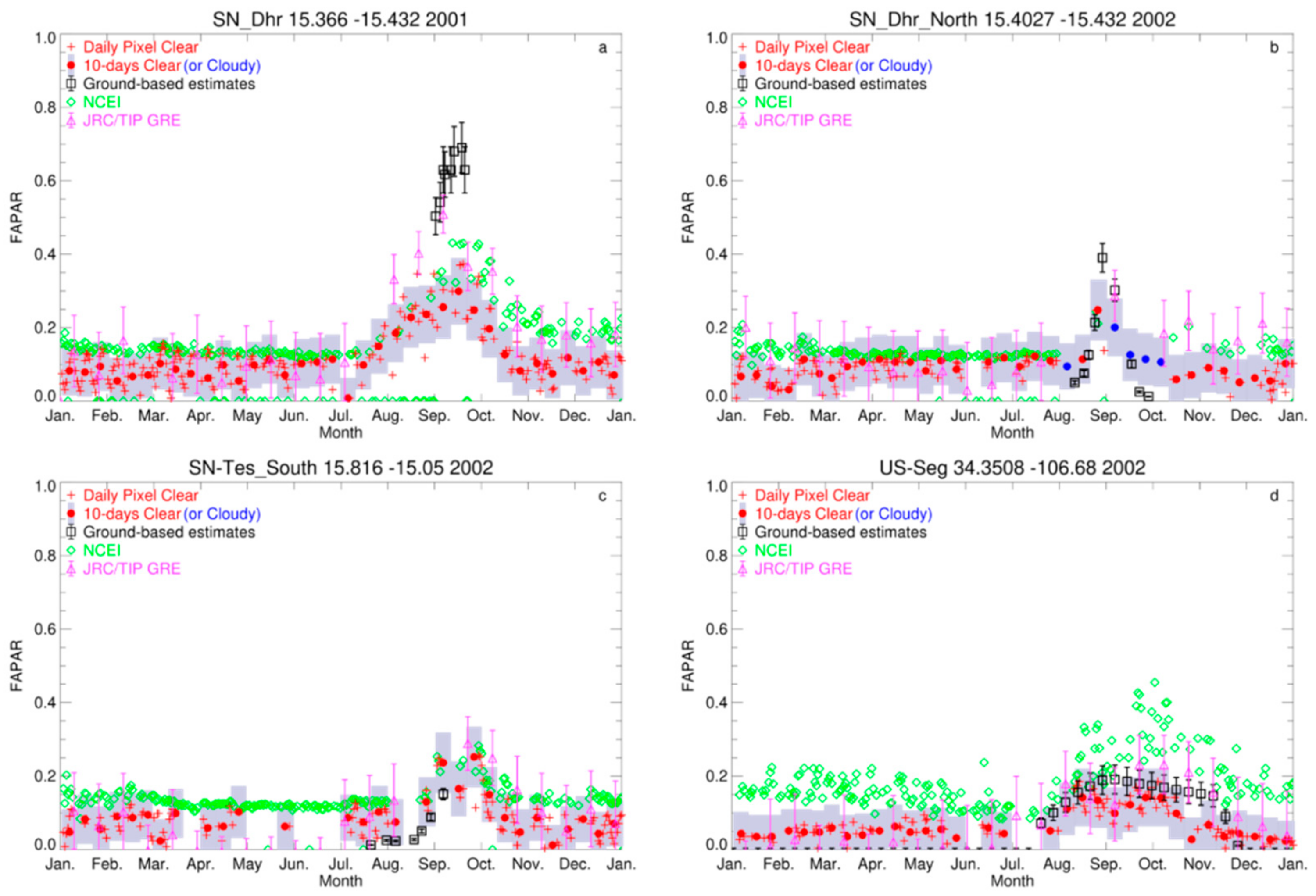
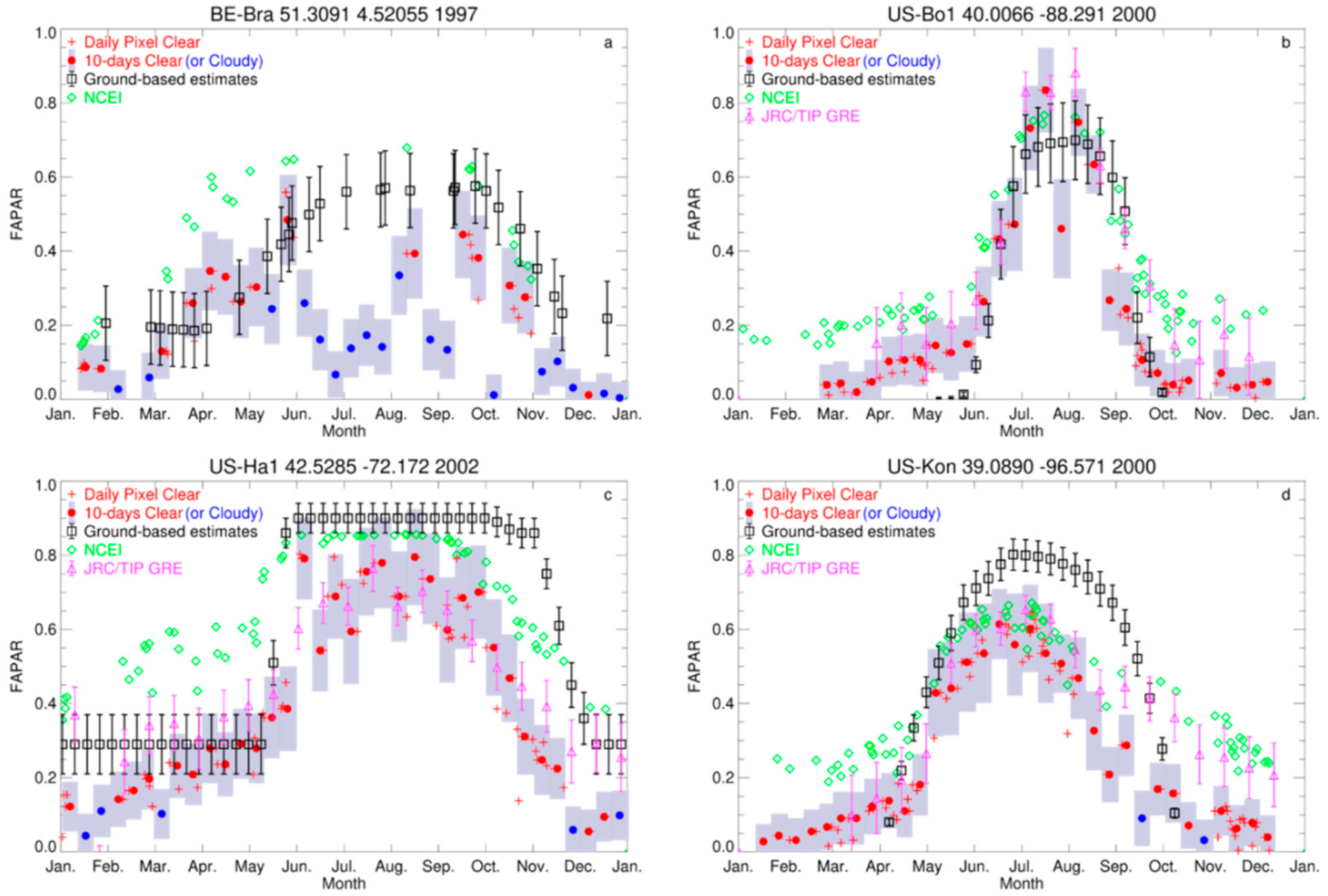
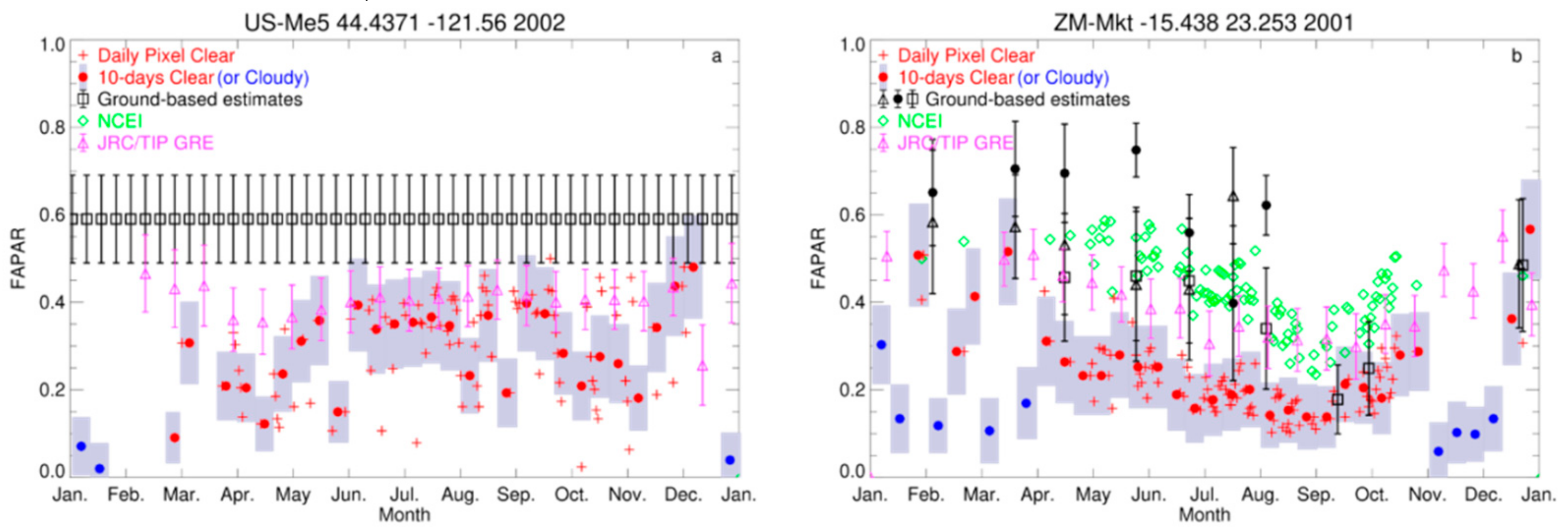






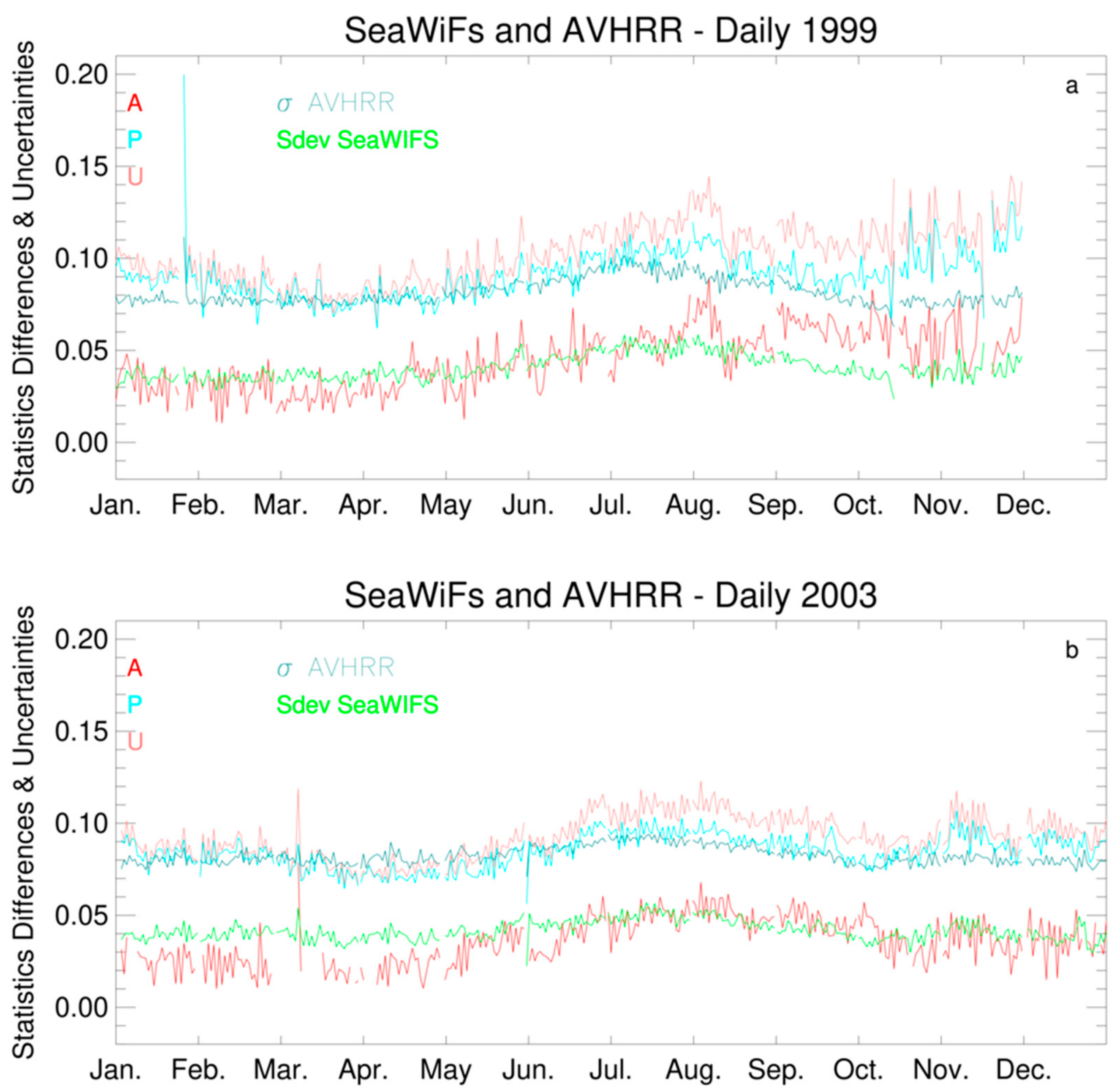
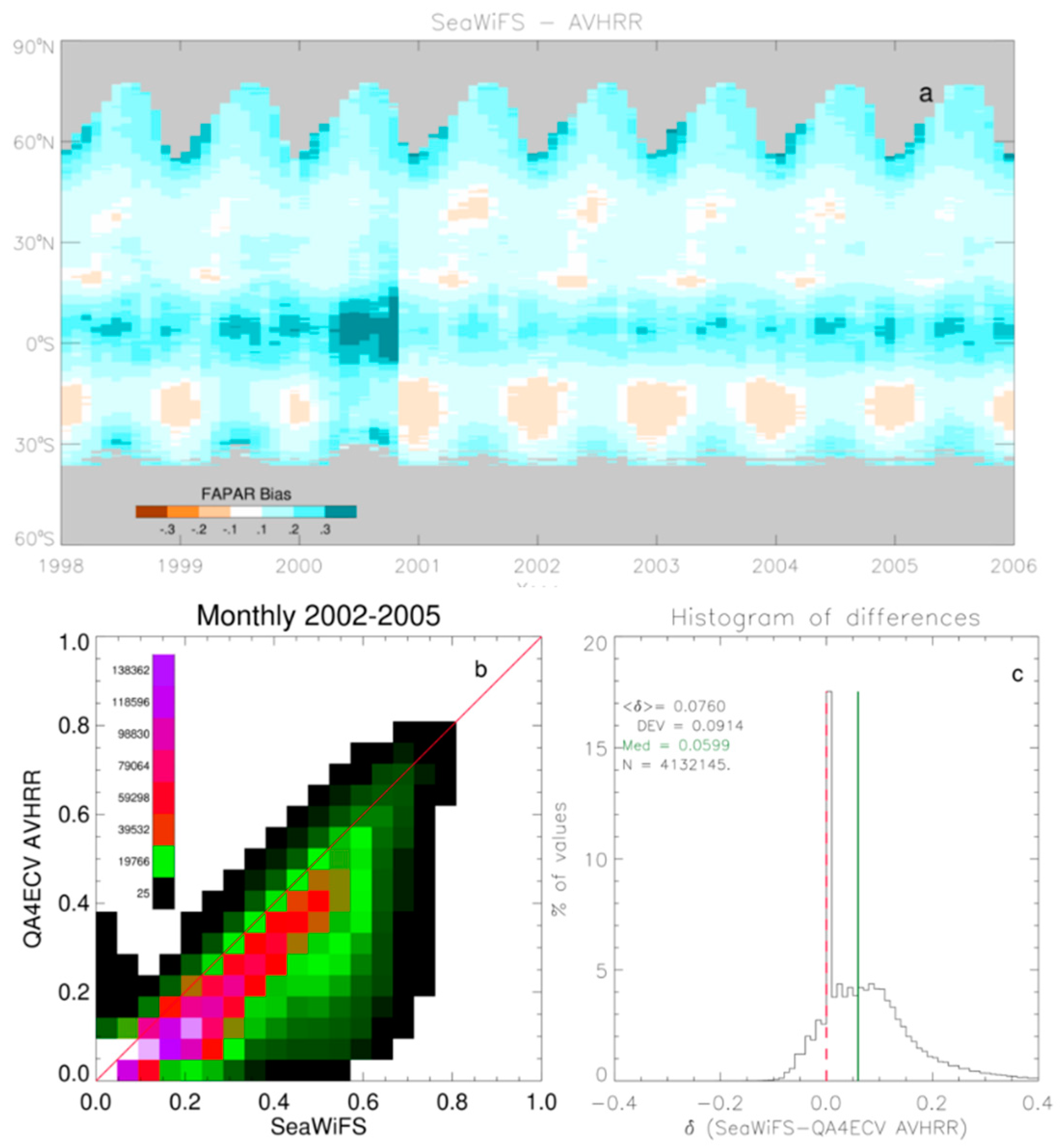
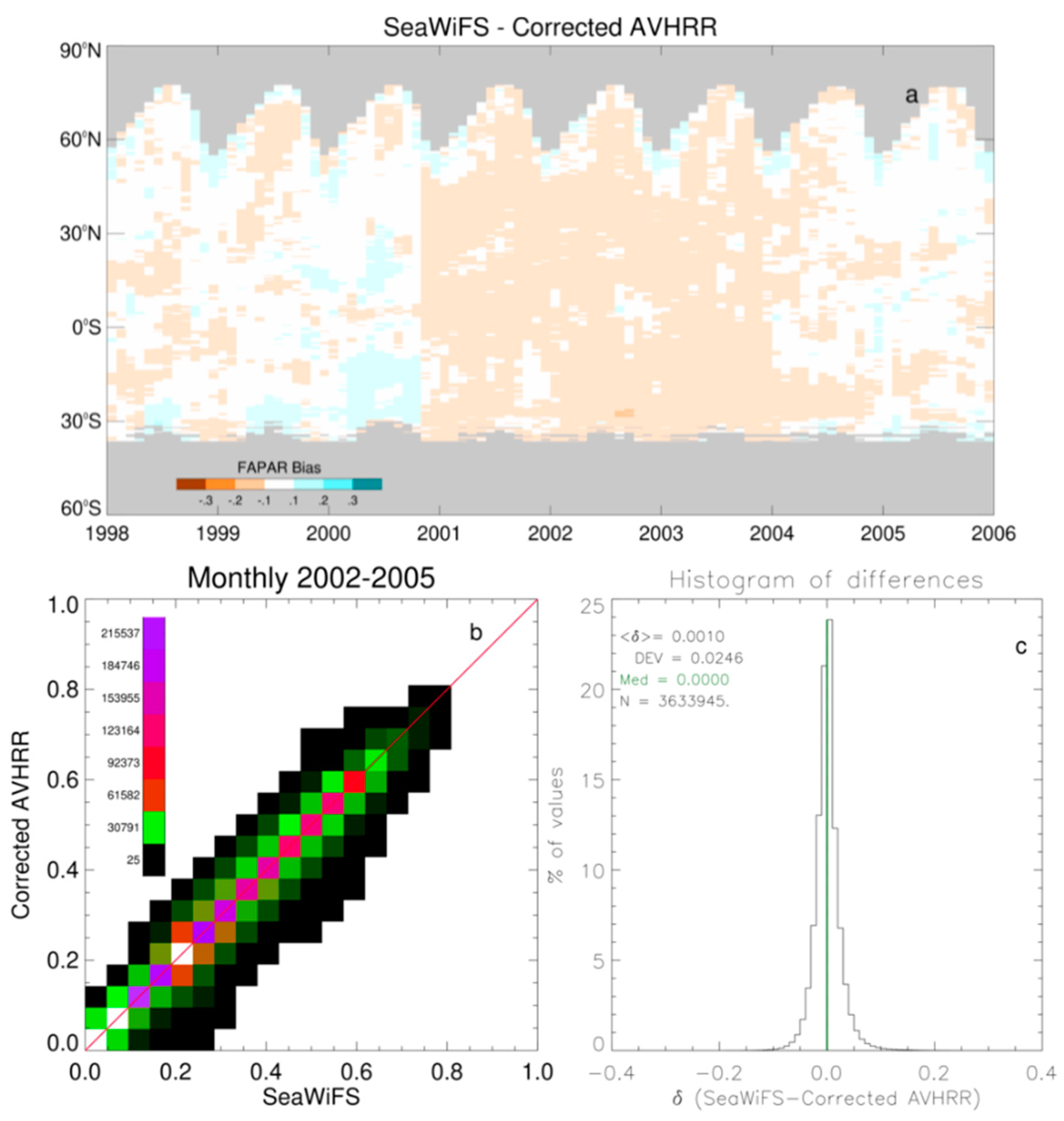
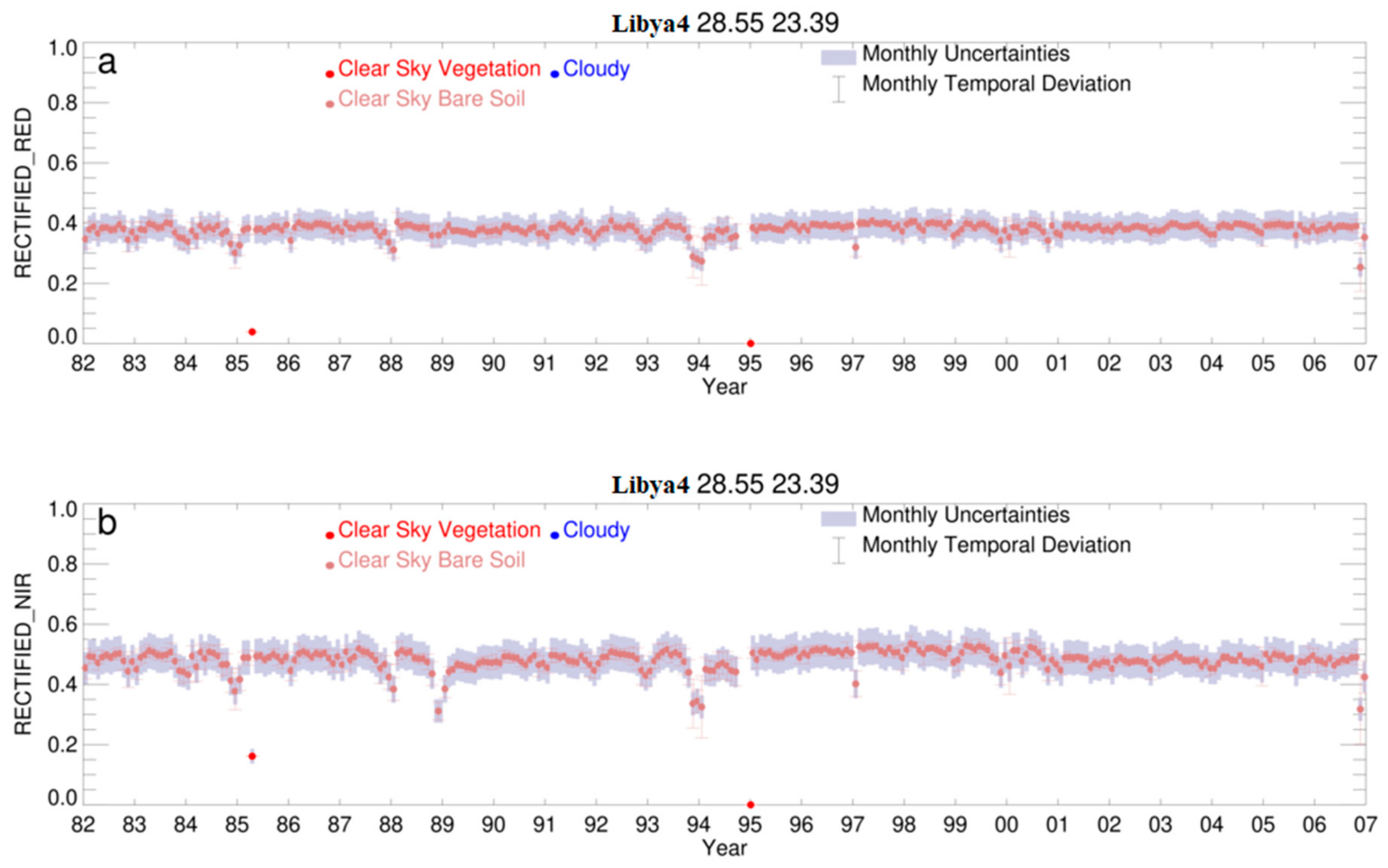
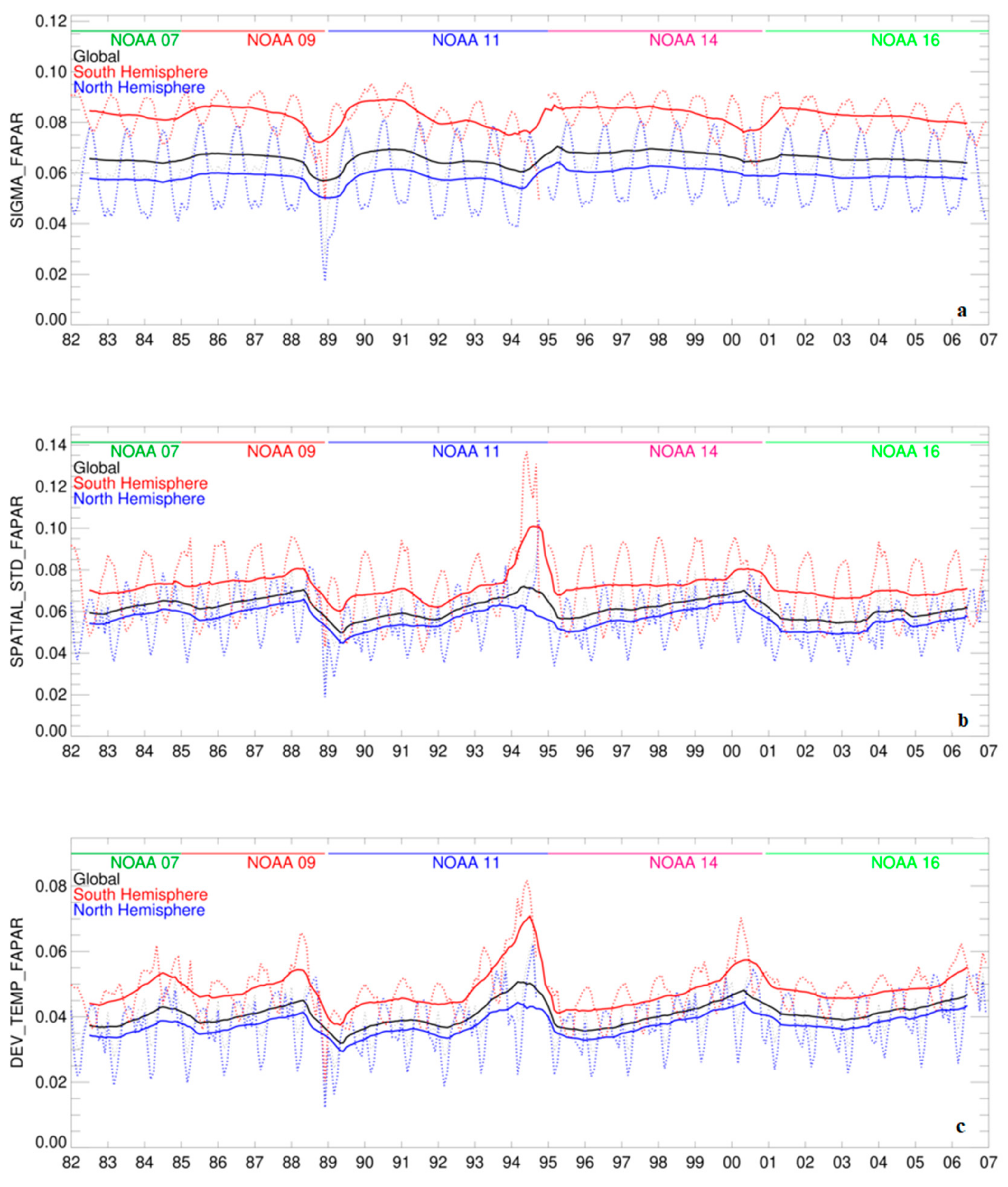
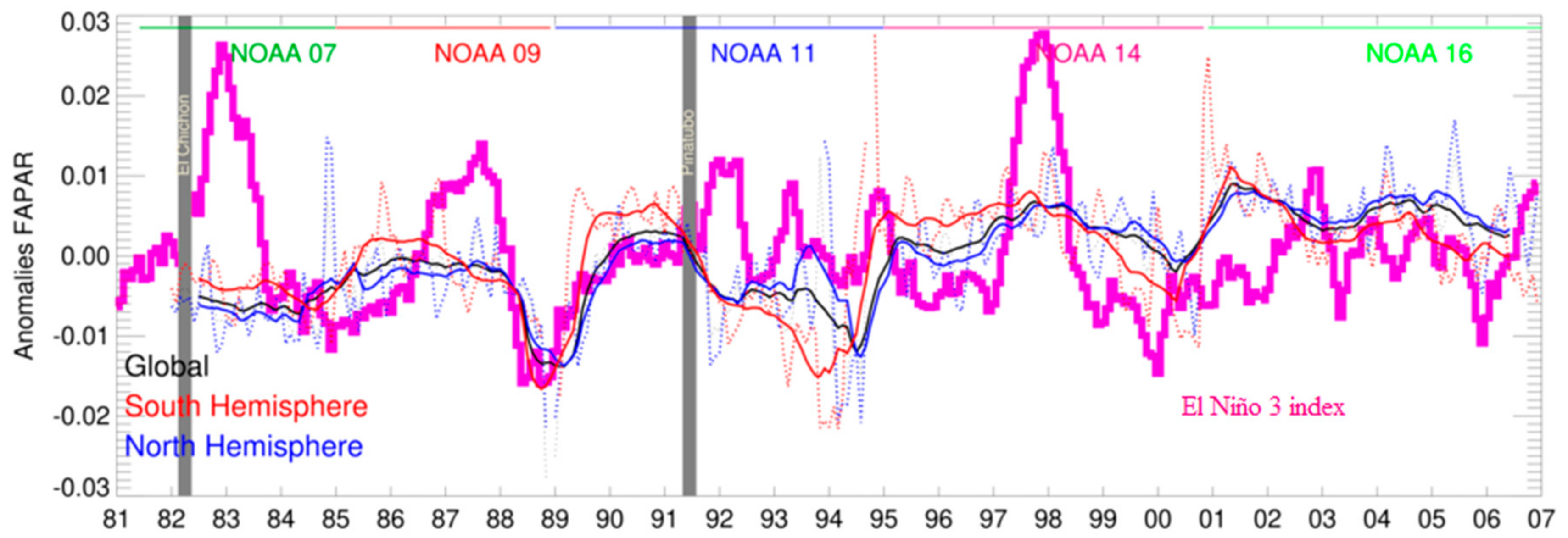
| Field Site Identification | Summary of Approaches to Domain-Averaged Fraction of Absorbed Photosynthetically Active Radiation (FAPAR) Estimations |
|---|---|
| SN-Dhr SN-Tes | Based on the Beer–Lambert–Bouguer (BBL) law with measurements of leaf angle distribution (LAD) functions FAPAR (µ0 (a)) derived from the balance between the vertical fluxes Leaf area index (LAI) derived from PCA-LICOR (b) |
| US-Seg | Based on the BBL law with an extinction coefficient equal to 0.5 (c) LAI derived from specific leaf area data and harvested above ground biomass Advanced procedure to account for spatio-temporal changes of a local LAI |
| US-Bo1 | Based on the BBL law with an extinction coefficient equal to 0.5 (c) LAI derived from specific leaf area data and harvested above ground biomass Advanced procedure to account for spatio-temporal changes of a local LAI |
| US-Ha1 | Based on the BBL law with an extinction coefficient equal to 0.58 (c) LAI derived from optical PCA-LICOR data Advanced procedure to account for spatio-temporal changes of a local LAI |
| BE-Bra | Based on full one-dimensional (1D) radiation transfer models LAI derived from optical PCA-LICOR data Time-dependent linear mixing procedure weighted by species composition |
| US-Kon | Based on the BBL law with an extinction coefficient equal to 0.5 (c) LAI derived from optical PCA-LICOR data Advanced procedure to account for spatio-temporal changes of a local LAI |
| US-Me5 | Based on the BBL law with an extinction coefficient equal to 0.5 (c) LAI derived from optical PCA-LICOR data Advanced procedure to account for spatio-temporal changes of a local LAI |
| ZM-Mkt | Based on the fraction of intercepted PAR estimated from the Tracing Radiation and Architecture of Canopies (TRAC) data slight contaminated by woody canopy elements |
| 1. “Fast variability” Short and homogeneous over a 1–2 km distance | 2. “Slow variability” Mixed vegetation with different land cover types | 3. “Resonant variability” Intermediate height and low density |
| SN-Dhr [39]: semiarid grass savannah | US-Bo1 [40]: corn and soybean | US-Me5 [40]: dry needleleaf forest |
| SN-Tes [39]: semiarid grass savannah | US-Ha1 [40]: conifer/broadleaf forest | ZM-Mkt [41]: shrubland/woodland |
| US-Seg [40]: desert grassland | BE-Bra [42]: conifer/broadleaf/shrub forest US-Kon [40]: grassland/shrubland/cropland |
| Site | Latitude (° N+) | Longitude (° N+) | Land Cover |
|---|---|---|---|
| Jarvselja-1 | 58.313 | 27.297 | Birch stand |
| Jarvselja-2 | 58.277 | 27.296 | Pine stand |
| Ofenpass | 46.663 | 10.230 | Pine stand |
| Lope | −0.169 | 11.459 | Tropical forest |
| Nghotto | 3.867 | 17.300 | Tropical forest |
| Zerbolo | 45.295 | 8.877 | Short rotation forest (poplar) |
| Thiverval-Grignon | 48.85 | 1.966 | Wheat |
| Wellington | −33.600 | 18.933 | Citrus orchard |
| Skukuza | −25.0197 | 31.4969 | Savannah |
| Janina | −30.077 | 144.136 | Shrubland |
© 2019 by the authors. Licensee MDPI, Basel, Switzerland. This article is an open access article distributed under the terms and conditions of the Creative Commons Attribution (CC BY) license (http://creativecommons.org/licenses/by/4.0/).
Share and Cite
Gobron, N.; Marioni, M.; Robustelli, M.; Vermote, E. Can We Use the QA4ECV Black-sky Fraction of Absorbed Photosynthetically Active Radiation (FAPAR) using AVHRR Surface Reflectance to Assess Terrestrial Global Change? Remote Sens. 2019, 11, 3055. https://doi.org/10.3390/rs11243055
Gobron N, Marioni M, Robustelli M, Vermote E. Can We Use the QA4ECV Black-sky Fraction of Absorbed Photosynthetically Active Radiation (FAPAR) using AVHRR Surface Reflectance to Assess Terrestrial Global Change? Remote Sensing. 2019; 11(24):3055. https://doi.org/10.3390/rs11243055
Chicago/Turabian StyleGobron, Nadine, Mirko Marioni, Monica Robustelli, and Eric Vermote. 2019. "Can We Use the QA4ECV Black-sky Fraction of Absorbed Photosynthetically Active Radiation (FAPAR) using AVHRR Surface Reflectance to Assess Terrestrial Global Change?" Remote Sensing 11, no. 24: 3055. https://doi.org/10.3390/rs11243055
APA StyleGobron, N., Marioni, M., Robustelli, M., & Vermote, E. (2019). Can We Use the QA4ECV Black-sky Fraction of Absorbed Photosynthetically Active Radiation (FAPAR) using AVHRR Surface Reflectance to Assess Terrestrial Global Change? Remote Sensing, 11(24), 3055. https://doi.org/10.3390/rs11243055





